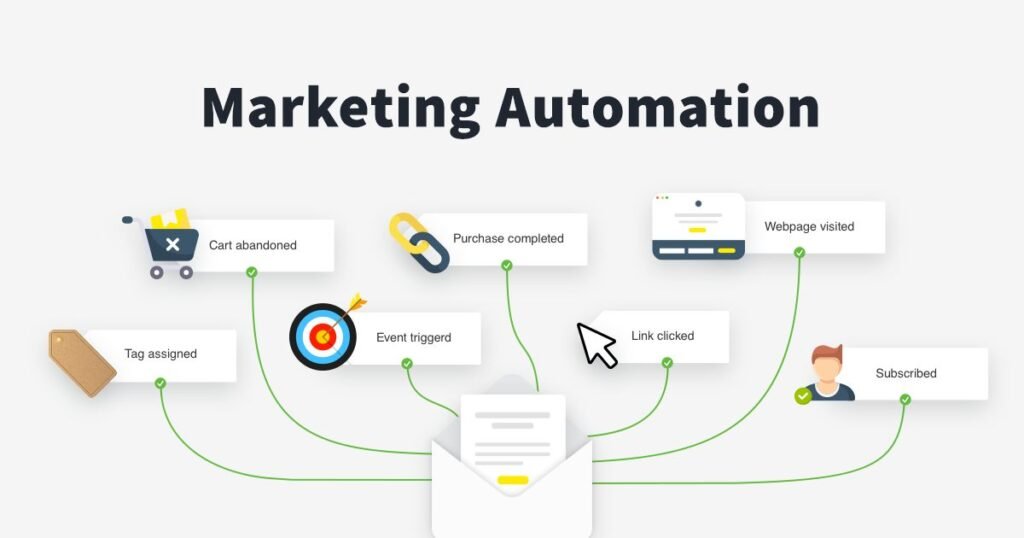Table of Contents
Understanding Marketing Automation Solutions

- Marketing automation solutions refers to the use of software platforms and technologies to automate repetitive marketing tasks and processes, thereby streamlining workflows, increasing efficiency, and driving more targeted and personalized campaigns. Business Onboarding guide you to marketing automation aims to nurture leads, engage prospects, and retain customers through timely and relevant communication across various digital channels.
- The key components of include email marketing automation, lead management and nurturing, customer segmentation and targeting, campaign management, and analytics and reporting capabilities. These features enable marketers to create, deploy, and analyze campaigns more effectively, ultimately leading to improved ROI and better customer experiences.
- Email marketing automation allows businesses to send personalized and timely emails to subscribers based on their behavior, preferences, and demographics. Lead management and nurturing involve tracking and managing leads throughout the sales funnel, from initial contact to conversion, using automated workflows and nurturing sequences to move leads closer to a purchase decision. Customer segmentation and targeting enable marketers to segment their audience based on various criteria such as demographics, behavior, and interests, allowing for more targeted and relevant messaging.
- Campaign management tools within platforms facilitate the creation, scheduling, and tracking of marketing campaigns across multiple channels, including email, social media, and SMS. Finally, analytics and reporting capabilities provide insights into campaign performance, allowing marketers to measure the effectiveness of their efforts and make data-driven decisions to optimize future campaigns.
- Overall, It empowers businesses to deliver the right message to the right person at the right time, driving engagement, conversion, and ultimately, revenue. By automating repetitive tasks and leveraging data-driven insights, marketers can focus their time and resources on strategic initiatives that drive business growth and success in today’s digital landscape.
Core Features of Marketing Automation Platforms
Marketing automation platforms offer a range of core features designed to streamline marketing processes and enhance customer engagement.
Firstly, email marketing automation allows businesses to create and send personalized email campaigns based on customer behavior and preferences. This feature automates email scheduling, segmentation, and follow-up, improving efficiency and effectiveness.
Lead management and nurturing capabilities enable businesses to track and manage leads throughout the sales funnel. Automated lead scoring helps prioritize leads based on their likelihood to convert, while lead nurturing workflows deliver targeted content to move leads closer to a purchase decision.
Customer segmentation and targeting features allow businesses to segment their audience based on demographics, behaviors, and interactions. This segmentation enables personalized communication and targeted campaigns tailored to specific audience segments.
Campaign management and multichannel integration features facilitate the creation, execution, and tracking of marketing campaigns across multiple channels, including email, social media, and websites. Integration with various channels ensures a cohesive and consistent customer experience.
Lastly, analytics and reporting capabilities provide insights into campaign performance, audience engagement, and ROI. By tracking key metrics and analyzing data, businesses can optimize their marketing strategies and improve results over time.
Implementing Marketing Automation: A Step-by-Step Guide

Implementing requires careful planning and execution to ensure its effectiveness in driving business growth. Here’s a step-by-step guide to help you navigate the process:
Assess Business Needs and Goals: Begin by identifying your organization’s marketing objectives and challenges. Determine what you aim to achieve with marketing automation, whether it’s lead generation, customer retention, or improving efficiency in campaign management.
Select the Right Marketing Automation Platform: Research and evaluate different marketing automation software options based on your budget, feature requirements, scalability, and integration capabilities. Choose a platform that aligns with your business goals and provides the functionality you need.
Data Integration and Migration: Ensure seamless integration of your existing customer data, including contact information, purchase history, and behavioral data, into the marketing automation platform. Clean and organize your data to ensure accuracy and consistency.
Set Up Workflows and Automation Rules: Define the workflows and automation rules that will govern your marketing campaigns. This includes creating automated email sequences, lead scoring models, and triggers based on specific actions or criteria.
Content Creation and Personalization: Develop compelling content that resonates with your target audience at each stage of the customer journey. Leverage personalization features within the marketing automation platform to tailor messages and offers based on individual preferences and behavior.
Testing and Optimization Strategies: Implement A/B testing and experimentation to optimize your marketing campaigns for maximum effectiveness. Test different messaging, subject lines, CTAs, and timing to identify what resonates best with your audience.
Training and Onboarding: Provide comprehensive training for your marketing team on how to use the marketing automation platform effectively. Ensure they understand how to create and manage campaigns, interpret analytics, and troubleshoot any issues that may arise.
Continuous Monitoring and Improvement: Monitor the performance of your marketing automation campaigns regularly and use analytics to track key metrics such as open rates, click-through rates, conversion rates, and ROI. Use this data to refine your strategies and make iterative improvements over time.
By following these steps and dedicating time and resources to proper planning and execution, you can successfully implement marketing automation to streamline your marketing processes and drive tangible results for your business.
Best Practices for Successful Marketing Automation
Best practices for successful marketing automation involve strategic planning, data-driven decision-making, and a focus on delivering personalized experiences to customers.
Build a Solid Foundation with Data: Ensure that your efforts are built on a foundation of accurate and comprehensive data. This includes clean data hygiene practices, data integration across systems, and regular audits to maintain data quality.
Focus on Customer Journey Mapping: Understand your customers’ journey from awareness to conversion and beyond. Use this insight to create tailored automation workflows that deliver the right message at the right time, guiding prospects through the sales funnel.
Segment Your Audience for Targeted Campaigns: Utilize data segmentation to divide your audience into distinct groups based on demographics, behavior, or preferences. This allows you to send highly targeted and relevant messages, increasing engagement and conversion rates.
Create Compelling and Relevant Content: Content is key in marketing automation. Develop high-quality, valuable content that resonates with your audience at each stage of their journey. Personalize content whenever possible to enhance relevance and effectiveness.
Measure and Analyze Performance Metrics: Track key performance indicators (KPIs) to evaluate the success of your marketing automation campaigns. Metrics such as open rates, click-through rates, conversion rates, and ROI provide valuable insights into campaign effectiveness and areas for improvement.

Continuously Iterate and Improve: Marketing automation is an iterative process. Regularly review campaign performance data, gather feedback from customers, and make data-driven optimizations to refine your strategies over time.
By following these best practices, businesses can maximize the impact of their marketing automation efforts, driving engagement, nurturing leads, and ultimately driving business growth.
Advanced Strategies and Innovations in Marketing Automation
Advanced strategies and innovations in marketing automation are revolutionizing how businesses engage with their audience, personalize experiences, and drive results. One of the most impactful advancements is the integration of artificial intelligence (AI) and machine learning (ML) into marketing automation platforms. AI-powered algorithms analyze vast amounts of data to predict customer behavior, optimize messaging, and automate decision-making processes. This enables hyper-personalization at scale, as marketers can deliver tailored content and offers based on individual preferences and past interactions.
Furthermore, predictive analytics is transforming lead scoring and forecasting. By leveraging historical data and behavioral patterns, predictive models identify high-value prospects and prioritize them for targeted nurturing efforts. This not only increases efficiency but also enhances conversion rates and revenue generation.
Dynamic content and real-time personalization are other key innovations in marketing automation. Dynamic content blocks adapt based on user attributes, such as location, demographics, or browsing history, ensuring relevant messaging across touchpoints. Real-time personalization takes this a step further by dynamically adjusting content in response to user interactions, delivering timely and contextual experiences that resonate with audiences.
Account-Based Marketing (ABM) has also seen a resurgence with marketing automation. ABM strategies focus on targeting key accounts with personalized campaigns tailored to their unique needs and pain points. Marketing automation facilitates account-based tactics by enabling account-level segmentation, automated outreach, and coordinated engagement across multiple channels.

Integration between marketing automation and Customer Relationship Management (CRM) systems is becoming increasingly seamless, allowing businesses to align sales and marketing efforts more effectively. By syncing data between platforms, teams gain a unified view of the customer journey, enabling smoother handoffs between marketing and sales and enhancing overall customer experience.
E-commerce businesses are leveraging marketing automation to drive conversions and maximize customer lifetime value. Automated workflows for abandoned cart recovery, product recommendations, and post-purchase follow-ups optimize the e-commerce journey, increasing sales and fostering loyalty.
Advanced strategies and innovations in marketing automation empower businesses to deliver highly personalized, data-driven experiences that drive engagement, conversions, and revenue growth in today’s competitive landscape. By embracing these advancements, businesses can stay ahead of the curve and build lasting relationships with their audience.
Conclusion
Implementing marketing automation is a transformative journey for businesses seeking to enhance efficiency, personalize customer interactions, and drive meaningful results. Throughout this step-by-step guide, we’ve explored the essential considerations, strategies, and best practices to ensure a successful implementation of marketing automation solutions.
First and foremost, it’s crucial to align the implementation process with your business needs and goals. Whether it’s improving lead generation, nurturing customer relationships, or optimizing campaign performance, a clear understanding of objectives is paramount.
Selecting the right marketing automation platform is another critical step. Evaluate platforms based on features, scalability, ease of use, and compatibility with your existing systems. Remember, the chosen platform should align with your current requirements while accommodating future growth.
Data integration and migration are often complex but necessary processes. Ensure seamless integration with existing systems to leverage customer data effectively. Clean, organized data lays the foundation for personalized and targeted marketing campaigns.
Setting up workflows and automation rules is where the magic happens. Design workflows that reflect your customer journey and automate repetitive tasks to save time and resources. Test and refine workflows to optimize performance continually.



Leave a Reply